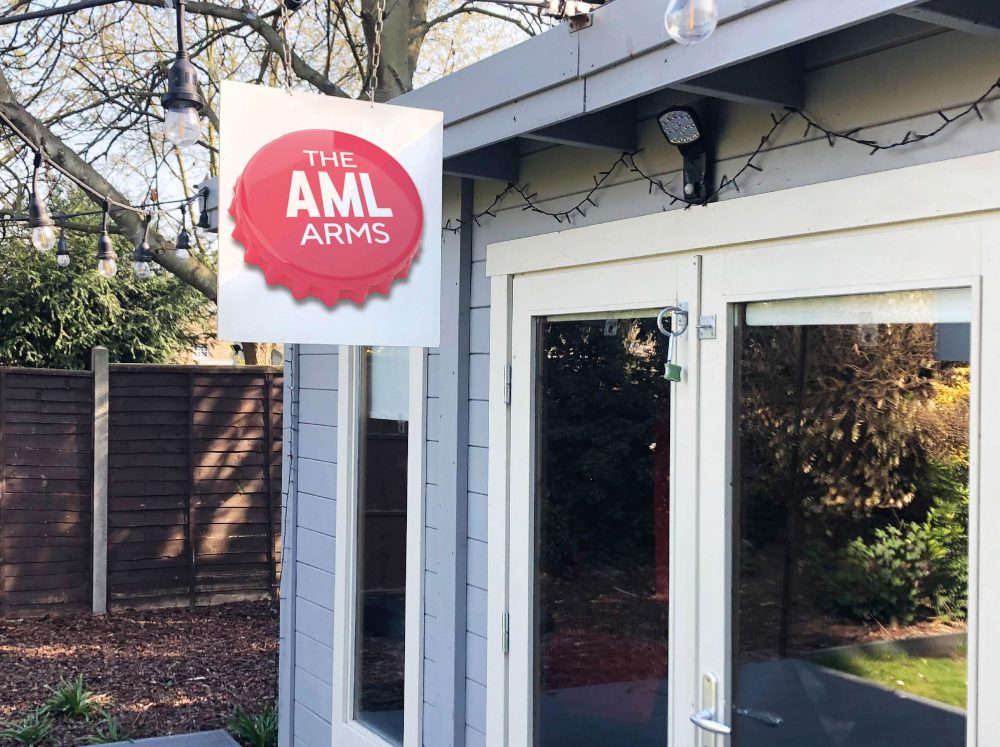Local resident and Head of Art, Chris Walker, has become a self-confessed local history nerd (personified by his alter-ego, Professor Walkaround, as featured above) since he and his wife Hobie, AML’s Head of Wellbeing, moved into Clerkenwell after 20 years in the suburbs raising a family. So Hobie ‘volunteered’ Chris to create a Scavenger Hunt/Photo Challenge/Pub Quiz/Historical adventure to show the rest of the AML-ers that there’s a whole extraordinary world just minutes from their computer screens. This would hopefully encourage people to take a proper lunchbreak and explore this ancient district.
[Things soon took a turn for the unexpected. After 6 weeks of unbroken sunshine, the heavens opened 2 minutes after the team’s set off , each with a different first destination.]
[Fortunately, each of the 3 rounds had a pub of local interest at its heart, so shelter was quickly found.]

The Green Team’s first clue took them 3 minutes away to Smithfield Market. For over 800 years the market has sold live cattle and meat. (Until 1855 cattle were slaughtered elsewhere and brought by train into a station underneath the market.) The tasks were to find out what else was occassionally sold, and to have a fitting photo taken by the memorial to William Wallace (aka Braveheart) who was hanged, drawn and quartered there in 1305.
Then into the splendid Fox and Anchor pub for a picture quiz. This pub has held an early licence for many, many years so that market workers could enjoy a pint or two after work. i.e. at 7am. The exterior art nouveau is the work of William J Neatby, who is famous for his work in Harrods’ Meat Hall.
The Red Team was sent to find the original Clerk’s Well after which Clerkenwell is named. The city’s parish clerks would perform miracle plays by the well as long ago as 1174. And then the team went to listen to the ancient River Fleet, which fed the well and supplied two monasteries with fresh water in the 12th century. The Fleet still flows, but now underground.
The Yellow Team then attempted a picture and factual quiz in The Betsey Trotwood – a pub named after a Charles Dickens character from David Copperfield. Dickens based many of his novels around Clerkenwell, most famously Oliver Twist.

The Blue Team popped across Clerkenwell Road to Clerkenwell Green, a place long associated with radicalism. Here the photo mission was to recreate a Soviet-style propaganda poster outside The Marx Memorial Library. From here, Vladamir Lenin wrote and printed the magazine The Iskra which was then smuggled into Russia to help sow the seeds of revolution. He was known to then nip over to The Crown for a pint. But it was into The Three Kings that our teams were sent for another quiz, over a suitably refreshing gin & tonic. Clerkenwell was at the centre of London’s first gin craze. The household names of Booth, Nicholson, Tanqueray and Gordon were all established in Clerkenwell.

Between 1720 and 1751, gin consumption reached its peak. Clerkenwell adults would drink an average of half a pint of gin a day. The gin consumption of the average child wasn’t far behind. At that time over 15% of adult deaths in Clerkenwell were attributed to the excessive drinking of spirits. Fortunately no AML staff perished.
And after more searching, photographing and quizzing, all teams reunited at the recently re-opened pub ‘The Sekforde’ on Sekforde Street, for judging, results, truly delicious bar food and even more refreshment.
It seems the agency had not only found a huge thirst for local history knowledge, but a reasonable sized thirst for gin. Purely for historical research reasons, you understand.


